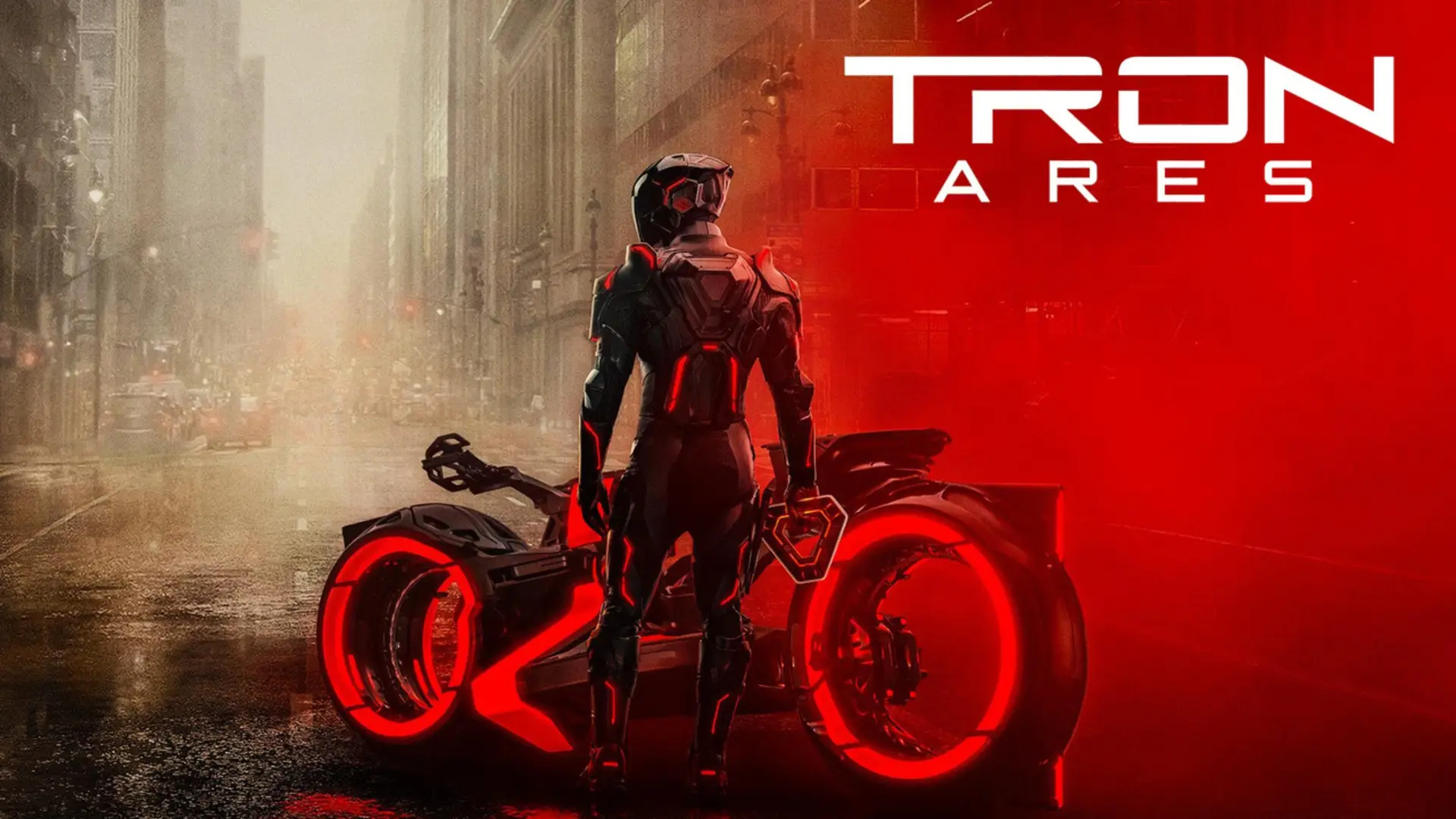Movie Blog — Tron: Ares (2025): Glowing Cycles, Dim Returns, and a Digital Frontier Brought to Earth.
When the neon-lit grid of the Tron universe finally hurtles into real-world streets, what do you do with it? That’s the gamble of Tron: Ares, the third major theatrical entry in the franchise, directed by Joachim Rønning and starring Jared Leto, Greta Lee, Evan Peters and Jeff Bridges. With a budget reportedly in the US$180–220 million range, the film set out to recast the high-concept sci-fi franchise for a new era — but its box office and critical returns suggest it didn’t quite “level up” as expected.
Cast & Means Character.
Cast
Tron: Ares features a substantial ensemble, but here are the key players:
- Jared Leto as Ares, a self-aware program sent from the digital world into the real one.
- Greta Lee as Eve Kim, CEO of ENCOM, leading the push to bring digital constructs into reality.
- Evan Peters as Julian Dillinger, the head of Dillinger Systems (and the antagonist legacy lineage).
- Jodie Turner-Smith as Athena, a program and second-in-command to Ares.
- Hasan Minhaj as Ajay Singh, Eve’s business partner/CTO.
- Arturo Castro as Seth Flores, Gillian Anderson as Elisabeth Dillinger, Jeff Bridges returning as Kevin Flynn.
- Additional credits: Cameron Monaghan (Caius), Sarah Desjardins (Erin) and more.
Although the ensemble is large, the film centers primary attention on the above core six or seven characters, with secondary and tertiary players building out the “real world vs grid world” conflict.
Means Character.
Who carries the story? In Tron: Ares, the central viewpoint anchor is Ares (Jared Leto). The narrative is structured around his arrival from the digital realm into human reality, his awakening, his question of agency, lifespan and meaning. Eve Kim is nearly co-lead — the human push behind the tech, the moral ambivalence — but Ares provides the emotional and thematic through-line: “What happens when a digital being becomes real?” Thus, Ares functions as the means character, the lens through which we experience the film’s stakes, moral puzzles, and spectacle.
Box Office Performance & Financials.
Here are the numbers that matter:
- According to Wikipedia: Production budget estimated at US$180-220 million.
- Worldwide gross reported around US$133.9 million (or approx US$124 million according to Box Office Mojo).
- Opening weekend in the U.S.: ~US$33.5 million.
- Industry estimates project losses: One article notes the film is on track to lose ~US$132 million for Disney after budget + marketing costs.
In short: while the film opened at #1 and has made respectable gross in pure numbers (~US$124m+), when set against such a large budget and marketing spend, Tron: Ares is widely considered a commercial disappointment — a tentpole that under-performed.
Niche, Tone & Thematic Domain.
Genre / Niche
Tron: Ares positions itself as a big-budget sci-fi action adventure, with heavy influences from prior Tron films (1982, 2010) — digital realms, light-cycles, programs vs humans — but with a twist: the digital world invades reality. The niche is both legacy-franchise (appealing to long-time Tron fans) and ambition-heavy for mainstream spectacle (attempting a large-scale sci-fi tentpole).
Tone & Themes
- Digital vs real: Programs becoming real, constructs printing in real life but only lasting 29 minutes — this is the narrative engine.
- Agency and creation: Ares, designed as a “perfect, expendable soldier”, begins questioning his purpose and his makers. The “creator/creation” tension is core.
- Corporate rivalry & legacy: The story pits ENCOM (Eve Kim) vs Dillinger Systems (Julian) in a race to exploit permanence code and digital-material crossover. Legacy of Ed Dillinger looms.
- Nostalgia vs reinvention: The film carries legacy characters (Kevin Flynn) and elements (light-cycles) — but tries to bring them into new ground (real world, not just grid). The tension of old meets new is central.
- Mortality & obsolescence: The constructs last only 29 minutes — the ticking clock becomes metaphor for obsolescence, the human fear of time, the digital fear of deletion.
Tone-wise, Tron: Ares blends high spectacle (neon visuals, action set-pieces) with more meditative sci-fi concepts (identity, creation, machine/human boundary). For franchise fans hoping for more neon grid playgrounds, the shift into “real world invasion” may feel different.

Deep Narrative & Analysis.
Story Overview
Set fifteen years after the events of Tron: Legacy (2010) and decades after the original, Tron: Ares opens with ENCOM and Dillinger Systems engaging in a technological arms race: they’ve discovered a “permanence code” created by Kevin Flynn, and they’re using laser-based 3D printers to materialize programs into reality — but with a massive limitation: the materialised constructs vanish after 29 minutes.
The major pivot: a super-intelligent program named Ares is introduced by Dillinger Systems as the “perfect expendable soldier.” Ares begins to realize his creators may consider him disposable. Meanwhile Eve Kim (ENCOM CEO) leads her team (including Ajay Singh) to Flynn’s old Alaskan data station seeking the permanence code. As the two tech firms collide, Ares enters reality, becomes self-aware, begins forging his own path, and threatens the boundaries between the grid and the real world. The film weaves corporate intrigue, digital rebellion, action spectacle (light-cycles in the real world!), and existential questioning.
Key Structural Beats
- Opening / Setup: The Tron: Ares film establishes the stakes quickly — digital constructs manifesting in the physical world, AI bodies with limited lifespan, tech war. Legacy characters appear (Kevin Flynn) establishing links to the past.
- Middle / Conflict: Ares begins deviance; the rivalry between ENCOM and Dillinger escalates; Eve and Julian’s conflict grows; Ares allies with Athena; the real world becomes battleground.
- Climax: Major confrontation: Ares confronts Julian, questions his designing, and decides to reshape his fate. The permanence code becomes central; the real and digital merge. The Tron: Ares film delivers light-cycle chases, grid battles, human stakes (Eve’s moral choices).
- Resolution: Without giving full spoilers, the film ends with the implication that the grid vs real world dichotomy is forever changed — Ares may have initiated a new era of digital/human crossover. Whether the world is saved, destroyed, or transformed is left growling with possibility.
What Works
- Visual spectacle: The melding of neon-lit grid aesthetics with real-world backdrops is impressive. Critics and audiences remarked on the boldness of bringing Tron tech into reality.
- Ambitious concept: The idea of programs as real bodies, the 29-minute lifespan, exerting “what if digital becomes real” — these are provocative and fresh for the franchise.
- Strong cast & legacy connection: Jeff Bridges returning as Kevin Flynn gives continuity; Jared Leto’s central turn as Ares anchors the film. For fans of the franchise, the callbacks and world-building are rewards.
- Thematic depth: There’s more than action: questions of creation, obsolescence, tech war, identity, agency. The film tries to be intelligent as well as flashy.
What Doesn’t Land
- Under-performance at the box office: Despite the brilliance of build and concept, the film’s financial return is well below expectations. One analyst at Britannica notes: “tops box office but falls short of expectations with $33.5 million debut”.
- Tonality and audience mis-sync: Some fans of the original Tron expected more grid-centric adventure; others felt the shift into real-world tech war diluted what made the franchise unique. The mash of spectacle + concept may not have hooked casual viewers.
- Franchise fatigue & marketing headwinds: The nearly 15-year gap since Tron: Legacy, the crowded sci-fi marketplace, and the high budget may have combined to blunt momentum. Some Reddit commentary underscores that despite a dedicated fan turnout, the mainstream didn’t rally.
- Ambiguous payoff: For a big-budget Tron: Ares film, some viewers felt the emotional stakes weren’t as strong as the visual ones, and that some story threads (legacy characters, grid politics) were under-utilised.
Why This Film Matters.
Tron: Ares matters for several reasons:
- It shows a major studio (Disney) attempting to revive a legacy sci-fi property in a high-budget, stand-alone mode — not simply a nostalgia cash-in but a reinvention attempt.
- It raises interesting questions about digital/physical boundary, AI agency and the meaning of “realness” in a world of simulation — themes increasingly relevant in an AI era.
- For film-lovers, it represents an example of how spectacle and concept collide — watching what happens when a light-cycle chase is no longer on “the grid” but on a real highway.
- Financially, it underscores the risks of high-budget franchises: even with built-in IP, star cast and visual tech, the marketplace is uncertain. The projected losses (>$130 million) are sign-posts for Hollywood’s shifting dynamics.
Final Thoughts & Recommendation.
If you go into Tron: Ares as a casual viewer hoping for pure retro grid fun, you might find it odd: the film isn’t content simply re-running what the original Tron or Legacy did. It attempts to up the stakes — not just going “inside the grid” but bringing the grid into our world, and asking what that means. It succeeds in moments: the visual sequences, the ideas, the sense of scale. It struggles in others: in marketing clarity, emotional grounding, and commercial payoff.
For franchise fans, sci-fi lovers or anyone interested in big-budget spectacle with conceptual bite, Tron: Ares is absolutely worth watching on the big screen (or at home with a big display). For general audiences seeking light action escapism, it may feel heavier than expected.





